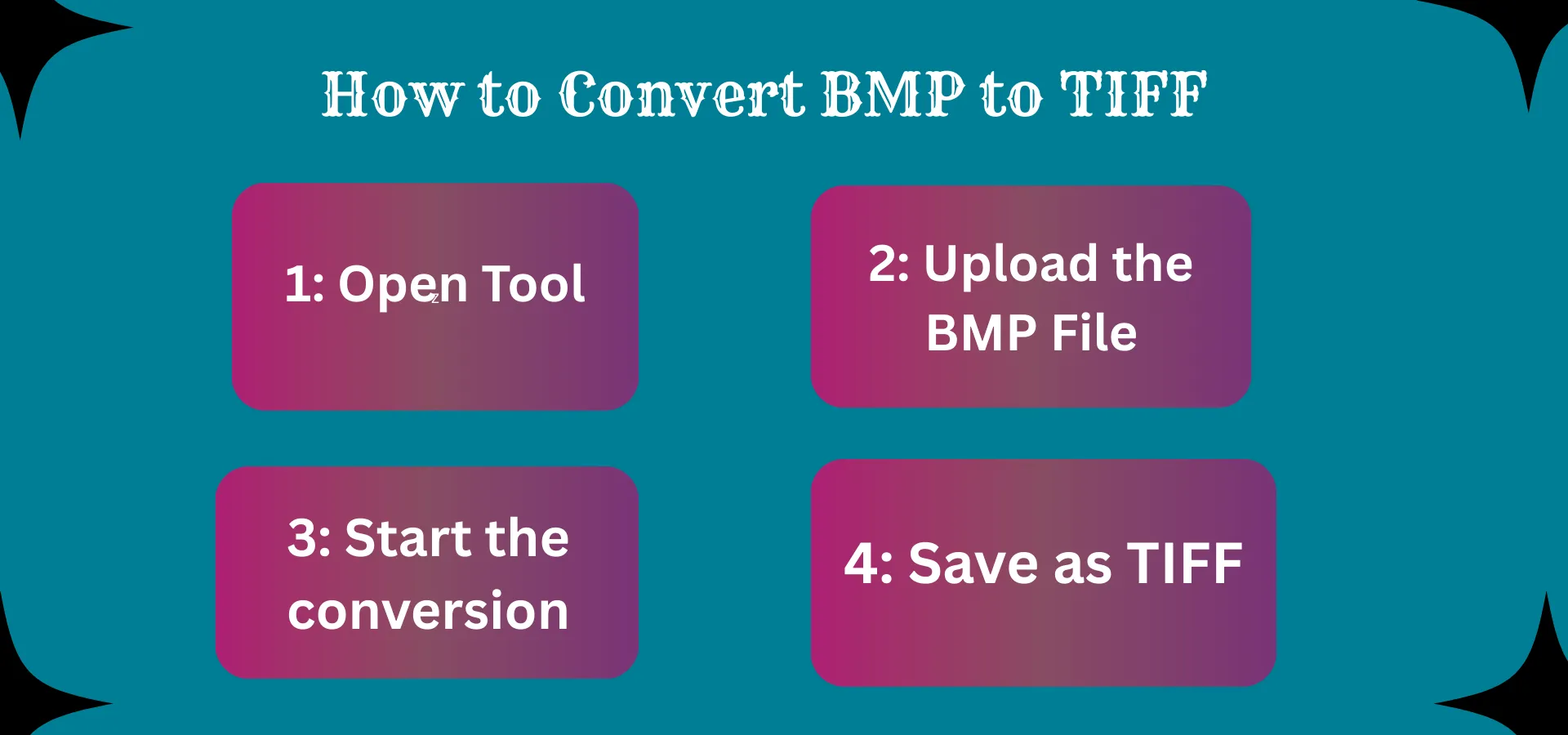BMP to TIFF Bulk Converter

What is BMP and TIFF?
Discover the two image types: BMP and TIFF prior to us learning how CodingIndia Labs BMP may serve as a TIFF converter.
BMP (Bitmap Image Structure) BMP is one of the oldest and simplest types of images. BMP holds image facts as a bitmap in such a way that each pixel is intentionally shaded. It is used mainly in the intentional production of uncompressed quality images. Since BMP does a lot that is not done in instructional writing, the image size of an image in BMP is enormous and can be limiting in configurations whose priority is dealing with large collections of images.
TIFF - Tag Image File Format is a very adaptable image file format used extensively in professional photography, publishing, and printing. As compared to BMP, the file format accommodates other schemes of compression, and thus it assists users in compressing their files without compromising quality. TIFF images also possess greater longevity than single-page, single-channel, or single-layer screens and thus are more suitable for high-resolution and detailed pictures.
Then you would ask, in the universe, why BMP graphics need to be output to TIFF? There are several reasons, including.
- In file compaction, Bicker graphics have a more compact way of compaction than BMP graphics, and thus can compact a file without a loss of quality.
- The editing flexibility of Bicker has several levels and channels, and thus is a good type for retouching and editing.
- Field Standard Bicker, by design, is the preference mode that is employed in photography, medical imaging, and graphic design owing to enhanced preservation.
CodingIndiaLab's Free BMP to TIFF Converter: Main Features
A BMP to TIFF image conversion software which can be used without any problem by professionals as well as even newbies has been created by CodingIndiaLab as well. Some of the new software features on the basis of which this software is listed very high above others which have been posted on the World Wide Web are as follows.
1. Free to Use
One of the greatest things about being able to work with CodingIndia Lab is that there are bills to be paid to pay it. There is no money upfront to pay for a subscription, and there is not even a worry about how much is going to be paid at the end. And you pay per limit on use. Share it as many times as you desire, exchange a picture for a thousand; give it to anybody free of cost.
2. Easy and Informative Interface
The program has also been planned in such a way that individuals with varying levels of knowledge as far as technical is concerned may use it conveniently. It has to be done only, and if you have no idea about image conversion, then you can simply use it. You simply have to upload your BMP file, select the TIFF type that you want to convert and press the button to convert. How user-friendly is the interface so that you don't have to learn the application in order to get used to it?
3. Batch Conversion
If the user is required to batch convert many pictures at once, CodingIndiaLab must be programmed with a batch parameter. Twenty BMP files may be uploaded simultaneously because as many as can be converted to TIFF simultaneously, which is much easier for photographers, graphic designers, and other users who are required to handle a thousand photos every day.
4. Preview Before Downloading
Apart from executing your BMP image to TIFF transformation, the converter also has a preview feature. Since you have already used the conversion tool of the converter, you can view the TIFF images and identify whether you will be downloading them or not. You can rest assured that you'll be satisfied with what you've got, and in case something goes awry, you'll know that beforehand before saving the file.
5. No Software Installation
Unlike other PC application software you install and download on your computer, Coding India Lab converter is web-based. You do not have to download and install anything, thus conserving machine space and time, while the software functions well with your web browser, thus very convenient to use on any laptop, tablet, or smartphone.
6. Safe and Secure
CodingIndiaLab attempts to be respectful and leave the patron alone. Your uploaded document is treated anonymously, and the photos don't hang suspended in mid-air over the waiter so that the translation system isn't ruined. Your facts are destroyed the moment you download the new TIFF photos, and your photo is treated anonymously.
7. Quality Conversion
The converter maintains the integral image during the conversion process. During the conversion of BMP to TIFF, you will never lose any of your statistics, and the images will be restored to high resolution. Using the quality of the end product for the company in otherwise good conditions is strictly prohibited.

Procedure to Convert BMP to TIFF by CodingIndiaLab's Tool
CodingIndiaLab BMP to TIFF converter is very simple to work with. You will follow your device's instructions step by step.
- Visit the page TIFF converter on the website CodingIndiaLab, and visit the page BMP of the TIFF converter. The main conversion and image upload interface is on this page
- To select a pre-existing BMP file nearby, you just need to click on the supplied Upload '' button. Perhaps there is even a single or several BMP files to be uploaded all at the same time or simply drag-and-drop them into the uploading area.
- To start the process of conversion, you just need to upload your file and then simply click on the "Convert" option. That will only take a minute to do, and the images will be saved as a new TIFF format file.
- Preview and Download TIFF Images. You can preview your converted TIFF images after conversion. You can download it if the output is in front of you. In batch mode, you even have hardware to download all the photos to a ZIP file for ease.
- After you download your recovered TIFF images, they may be stored, used for commercial purposes, or stored without limitation. Quality conversion renders your images readable and understandable format.
Why You Should Prefer CodingIndiaLab's Tool Over Others?
Many image conversion tools are available online, but CodingIndiaLab performs a broad variety of operations.
- In contrast to all other computer software, which can be used for free with limited facilities or at subscription rates, CodingIndia Lab is cost-free.
- Easy to Use: The Easy, user-friendly interface of the software makes it simple to use even by novices without apprehension.
- Batch conversion is restricted to one file only, but Coding India Lab offers a substitute for converting up to 20 BMP files at one time.
- The software protects your file from unauthorized access by encrypting and erasing it, thus maintaining your secrecy.
Thank You for Using Our Tool
We would love to hear your feedback. Your review will help us continue improving.
Please Review Us
Rate Us Now – Your Opinion Helps Us Grow!
Other Related Tools
FAQs on BMP to TIFF Converter
Tabs
The organization of a TIFF file is severely constrained by the size of the file.
Since TIFF is usually used in restoring losslessly compressed or compressed images, the file size will be very large, especially in restoring high-resolution images. That would not be easy to store and manage at the same time as a collection of images. In addition, a TIFF file can take up more space and longer uploading, downloading, or sending time as long as it is not file size-limited.
Below are the advantages of recovering a file in a TIFF file format.
The file format supports higher-quality images with minimal loss of statistics, which is suitable for professional programs. TIFF can be compressed without loss and stored uncompressed in a manner such that the image will not lose its original data. TIFF also supports some extra layers and channels, hence editing and manipulation become easy. TIFF is also available with the majority of image management systems and, therefore, can easily be employed in most firms.
TIFFs are most valuable in uses where image quality is absolutely critical business photographs, graphic design, medical images, just to name a few. That's when you need to be able to save those images and photos with high resolution and all their layers, scanned pictures, artwork, that sort of thing.
Second, its lossless compression ensures that your high-definition images will be unchanged. None of the definition or detail will be lost. That's why it's so widely used in commercial photography and print publication. TIFF will play nicely with layers and multipage files, and it's a wonderful option to use to process complex pictures. Additionally, it is very compatible with nearly all image edit programs, so you can use it for heavy-duty image editing and long-term storage of files.
You can store pictures in compressed and uncompressed form so you have the freedom of choice between file size and quality of picture. That freedom of choice is one of the big pluses of TIFF.
Your Rating : Good!